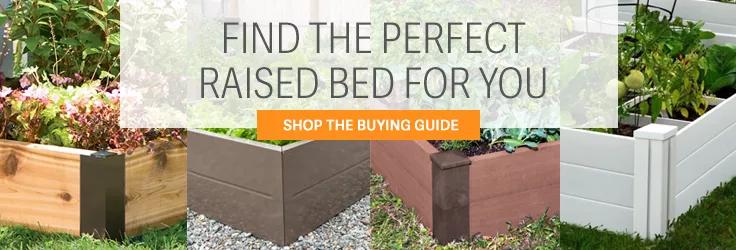How to Build a Raised Garden Bed
Our aluminum Lifetime Corners make DIY raised beds easy!
Build It: Raised Bed Corners and Connectors are Fast and Foolproof
Are you ready to build your own raised bed? Enjoy all the glory of a "I built this myself" project, with none of the agony that comes with purchasing all the wrong individual bits of hardware in an attempt to make a square corner. Just bring the lumber and we'll take care of the rest.
The hardest part of building a raised bed is constructing corners that are square, strong, and tidy-looking. A raised bed full of soil, plants, and water (that's 8 lbs per gallon, right there folks) can get very heavy, and most of that weight stress gets placed on corners and seams. Our ingenious Raised Bed Corners are brackets that result in a structurally-sound, sturdy bed that won't blow out on you midseason. Slip your own milled lumber into the corners and insert the included screws. That's it.
For gardeners looking to think outside the box, Pivoting Raised Bed Corners let you build beds in all kinds of shapes, from octagons to triangles. These are especially useful for small yards and spaces, where a traditional rectangle bed may not fit. And for those looking to go the opposite direction, the In-Line Connectors allow you to lengthen an existing raised bed without the risk of bowing.
No easy access to lumber? Fear not, we've got pre-milled, rot-resistant cedar boards ready to go.
Fill It
Once your raised bed is built, it's ready to be filled with soil. Raised beds give you an immediate advantage over an in-ground garden, because you can fill it with a custom blend of soil that's superior to the native soil in your backyard. Soil that's loose and rich with organic matter will allow the roots of your plants to grow freely, and ensure that they have access to the water and nutrients they need. Look for a specialty raised bed mix if you have a single small bed to fill. If you plan to fill more than one raised bed, you may want to buy your soil components in bulk — by the cubic foot or cubic yard — and mix yourself. Aim for 50-60% topsoil and 40-50% compost. Blending in additional organic matter, such as leaf mold,as your crops grow, will further enhance soil microbial life and improve moisture retention in your garden bed.
Not sure how much soil you need? Check out our Soil Calculator for a quick number crunch.
Plant It
Here comes the fun part — PLANTING. Are you a greens and beans type of gardener? Check out our Kitchen Planner for tons of raised bed designs that feature veggies and herbs. Try to include at least one vegetable that’s new to you. Craving fresh bouquets to share with friends and sprinkle around your home all season long? Try planting a cut flower garden. Fill your raised bed with zinnias, sunflowers, cosmos, marigolds, ageratum, and other super-easy-to-grow annual flowers.
Of course there is no one stopping you from filling your raised bed with a gorgeous blend of vegetables, herbs, flowers, and fruits. We're excited to see what kind of garden YOU build!
 This kitchen garden is DIY, made with our raised garden bed kits.
This kitchen garden is DIY, made with our raised garden bed kits.
Print this Article:
Get the Dirt
Stay up to date on new articles and advice. Please fill out the information below.

